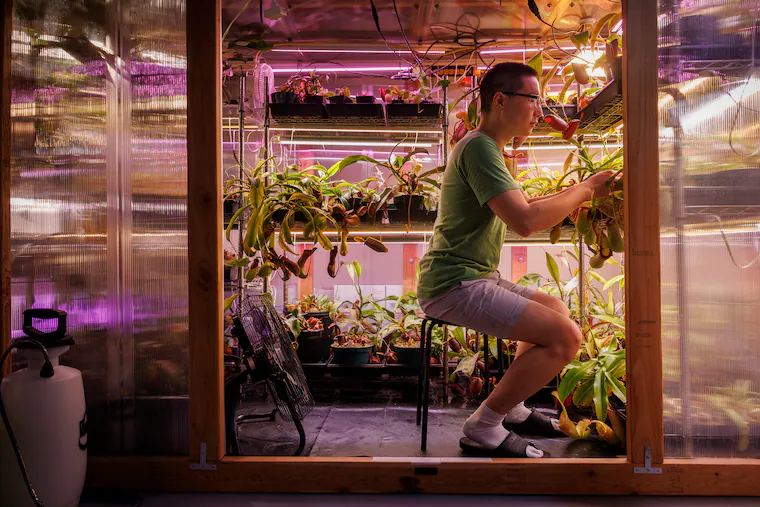
TANNERSVILLE, Pa. — Kevin Zhang came to a screeching halt.
“Oh, wow,” he belted, squatting alongside the rickety wooden path suspended above the Tannersville Cranberry Bog in the Poconos.
Members of the Mid-Atlantic Carnivorous Plant Society crowded, crouched, and craned their necks at a sarracenia’s trumpetlike flower. Zhang marveled at its venation.
“Really striking,” he commented, “really beautiful.”
With closer inspection, the sarracenia bared its “teeth”: slippery hairlike structures that lure insects with the promise of nectar, then trap them. Bugs caught in the fray either drown or die from exhaustion trying to escape.
Rare, murderous flora have long captivated Hollywood and Broadway, but for onlookers that Saturday in mid-September, any fear was eclipsed by fascination.
And the outing at the Tannersville bog — roughly 75 miles north of Philadelphia — was intended as a prelude to the society’s inaugural celebration of the wacky, weird, and predatory Oct. 11 at Haverford College.
“The beauty, the fun,” said member Jerry Smith, 72, of northern New Jersey, “it’s the cool factor.”
Mild to meat eaters
Founded in 2017, the Mid-Atlantic chapter connects carnivorous-plant enthusiasts and self-described nerds from New York state to Virginia. The group has grown to as many as 80 dues-paying members, an eight-position board of directors, and an email list of 400, according to Zhang, the chapter’s president. Members include a doctor, a Philadelphia jeweler, and an anthropologist.
“You’ve got to have an interest in science,” Smith said. “You have to have an interest in growing things. You have to have an interest in plants. If you don’t, you’re in the wrong place.”
How seemingly mild-mannered plants evolved into meat eaters has intrigued scientists since Darwin.
The 860 known carnivorous species grow in bogs or other waters and environments poor in essential nutrients. Over millions of years, these plants evolved to survive without getting fuel from the soil, instead eating what was available to them. And, well, bugs are packed with protein.
Some species, like the pitcher plant family, catch their prey passively. Others curl around their victims or snap them in their jaws. And despite lurid tales of mad scientists and hapless florists — “Feed me, Seymour!” cries the bloodthirsty Venus flytrap-inspired Audrey II in Little Shop of Horrors — these plants don’t feed on human flesh, rather the occasional small, succulent frog. (A pitcher plant found only near the summit of Mount Victoria in the Philippines can grow large enough to digest rodents.)
“I wanted to get a plant that was more like a pet,” said Drew Porter of Schwenksville, while strolling through the bog with his two kids and his wife, Coral. Porter opted for a Venus flytrap. Since then, his collection has grown to about a dozen.
Society vice president Rick Roberts got hooked after seeing nepenthes, a tropical pitcher plant, in a nursery greenhouse at age 18.
“Before long, I had another one and another one and another one, and then they kind of exploded,” he said over a Zoom call.
The rules for cultivating these predatory plants are distinct from an average philodendron, monstera, or pothos houseplant: Keep the soil moist to mimic swampy habitats, don’t use fertilizer, and no tap water, only distilled. Before he sold off roughly a third of his stash, Smith said, his lot of carnivorous plants sopped up as much as 15 gallons — about a beer keg’s worth — of water, daily.
A whole world of fascination
The group’s forthcoming plant show promises something for everyone from curious kids and beginner botanists to hobbyists hoping to see some very rare plants. On the one-day agenda: speakers, more than 20 vendors, a guided tour of Haverford’s arboretum, raffles, and a judged best-of-show competition complete with prizes.
At the least, Zhang wants all attendees to walk away with this: Do not water these plants from the tap.
Board member David Wallace hopes the event will also spur conservation efforts: Almost a quarter of carnivorous-plant species — some of which are found only on the vertical granite cliff faces of Mount Kelam in Indonesia or in small pockets of the Carolinas’ coastal plain — risk extinction due to climate change, industrialization, and poaching of these plants from their natural habitats, according to a 2020 study.
“It’s enough of a rarity for people to see a lot of this stuff at all,” Roberts said.
“We’re really hoping to show to everybody that it’s not just about that flytrap you saw one time at the store — there’s a whole world out there of plants, and they’re super fascinating.”



